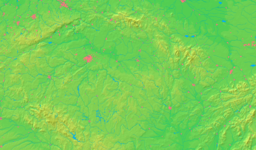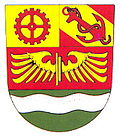- Děčín
-
Děčín Town FlagCoat of armsCountry Czech Republic Region Ústí nad Labem District Děčín Rivers Elbe, Ploučnice Elevation 135 m (443 ft) Coordinates 50°47′N 14°13′E / 50.783°N 14.217°E Area 118.04 km2 (46 sq mi) Population 52,864 (April 2007[update]) Density 448 / km2 (1,160 / sq mi) First mentioned 993 Mayor Vladislav Raška Timezone CET (UTC+1) - summer (DST) CEST (UTC+2) Postal code 405 02 Wikimedia Commons: Děčín Website: www.decin.cz Děčín (Czech pronunciation: [ˈɟɛtʃiːn]; German: Tetschen) is a town in the north of the Czech Republic. It is the largest town in the Děčín District. Near the German border, not far from Dresden and 83 minutes north of Prague by rail, the city of Děčín in the Ústí nad Labem Region is on the trade route between the Czech Republic and Germany. All cargo transported by road, rail and water passes through the town, as it is also at the meeting-point of the rivers Elbe (Labe in Czech) and Ploučnice. Děčín is actually made up of two towns, one on either side of the river Labe; the old town of Děčín is on the right bank, and on the left bank is Podmokly (German: Bodenbach) which became part of the town in 1942.
The Labe having cut through the soft sandstone of the region, the town is at the centre of three low mountain ranges; Děčínská vrchovina (the Děčín Highlands), České Středohoří (the Czech Midlands) and Lužické hory (the Luzice Mountains).
Products made in Děčín include sheet-metal, food, textiles, chemicals, soap, beer and preserved fish; the town is also home to a printing and publishing industry.
Contents
History
The Děčín (Tetschen) area was settled by the Slavic tribe of the Děčané in the 9th century, whence its name. At first it was built on the left bank of the Labe, but after a flood it was rebuilt on the right bank in 1059. It was under the control of the Lords of Wartenberg from 1305 until 1534, when it was bought by the rich Lord Rudolf von Bünau. This family introduced Protestantism to the region but that religion was suppressed after the Bünaus were driven out in 1620. Bünau sold the town in 1628 to the Baron of Thun.
In the 18th century, Tetschen followed fashion and became a spa town under Baron Johann Joseph Thun, who searched the area for a suitable spring and found one in Horní Žleb in 1768. The center of a busy trading hub was not, however, the ideal place to build a spa, and the idea was eventually dropped in 1922; today the town's spa past has been largely forgotten.
In August 2002, extreme weather conditions lead to extensive flooding all across Europe and Děčín was also badly hit. Water levels rose from their usual two meters to 12 meters; five barges broke loose from their moorings and threatened to break apart a town bridge and float on towards Dresden before demolition experts sunk them with explosives. At one point 1,600 people were evacuated. Fortunately, the historic center and also many of the tourist spots are at higher elevations, so they were left undamaged, but many lower lying buildings were ruined.
Attractions
- Synagogue, 1907
- Renaissance bridge
- Holy Rood Church, 1687–1691
- "Sheep's Bridge", 1620
- Děčín castle (zámek Děčín), 1305
Děčín castle is probably the most popular tourist attraction in the town. Built on a hill near the town centre and overlooking the Labe river, the castle has enjoyed an extremely varied history. It has gone from being a fort during the Seven Years' War, to becoming a Renaissance castle in 1673, to turning Baroque after its restoration in 1788. Once the home of Bohemian kings (having been built by order of Premysl king Václav III) the castle has since functioned as the administrative centre of the Thuns and even as a military garrison for German and Soviet troops after being handed to the Czechoslovak state in 1932. The castle has inspired both musicians - Chopin wrote his Valse in A flat major here - and artists; Caspar David Friedrich sold his "Tetschen Altar Or Cross In The Mountains" to the Thuns. An unusual feature of the castle is the long, straight-walled road leading up to it, the "Long Ride" (Dlouhá jízda).
The Soviet army departed in 1991, leaving the castle in a state of disrepair. In 2005 restoration was completed of a large part of the castle and it was opened as a museum and venue for private gatherings and public events. Most of the inventory had been taken away by the Thuns after they sold the castle to the Czechoslovak state in 1932. Much of the remaining period furniture was gradually stolen, but some pieces which had been kept at other museums were returned.
In the river Labe near the left bank there stands a 6 m2 (64.58 sq ft) basalt stone which is only visible when water levels are low, which usually means the region is suffering from drought. The stone is known as the Hunger Stone, because in olden times, when it appeared, all boat traffic on the river came to a halt, and people suffered as a result. The lowest water levels have been marked on the stone since 1417, and the markings from 1616 on are still readable. The stone carries the inscription "If you see me, then cry".
Notable residents
- Miroslav Tyrš (1832-1884), founder of the Sokol physical education
- Julius Arigi (1891–1985), leading Czech flying ace during World War I
- Egon Klepsch (1930–2010), German politician
- Jiří Bartoška (1947), Czech actor and the president of the Karlovy Vary International Film Festival
- Vladimír Šmicer (1973), Czech football player
- Karolína Kurková (1984), World top-earning model
Image gallery
External links
- Tetschen, Bohemia Historical Map of 1615 by Petrus Bertius
- Town homepage - in Czech
- Town homepage - in Czech, English and German
- Decin Castle - official homepage
- Decin Castle
- Decin ZOO
- Article on Děčín in the English language Prague Post, 28 April 2005
- Article on the reopening of Děčín castle, 20 May 2005 - in English
Towns and villages of Děčín District Arnoltice · Benešov nad Ploučnicí · Bynovec · Česká Kamenice · Děčín · Dobkovice · Dobrná · Dolní Habartice · Dolní Podluží · Dolní Poustevna · Doubice · Františkov nad Ploučnicí · Heřmanov · Horní Habartice · Horní Podluží · Hřensko · Huntířov · Chřibská · Janov · Janská · Jetřichovice · Jílové · Jiřetín pod Jedlovou · Jiříkov · Kámen · Krásná Lípa · Kunratice · Kytlice · Labská Stráň · Lipová · Lobendava · Ludvíkovice · Malá Veleň · Malšovice · Markvartice · Merboltice · Mikulášovice · Rumburk · Růžová · Rybniště · Srbská Kamenice · Staré Křečany · Starý Šachov · Šluknov · Těchlovice · Valkeřice · Varnsdorf · Velká Bukovina · Velký Šenov · Verneřice · Veselé · VilémovCategories:- Cities and towns in the Czech Republic
- Děčín District
- Elbe Sandstone Mountains
- Bohemian Switzerland
Wikimedia Foundation. 2010.










